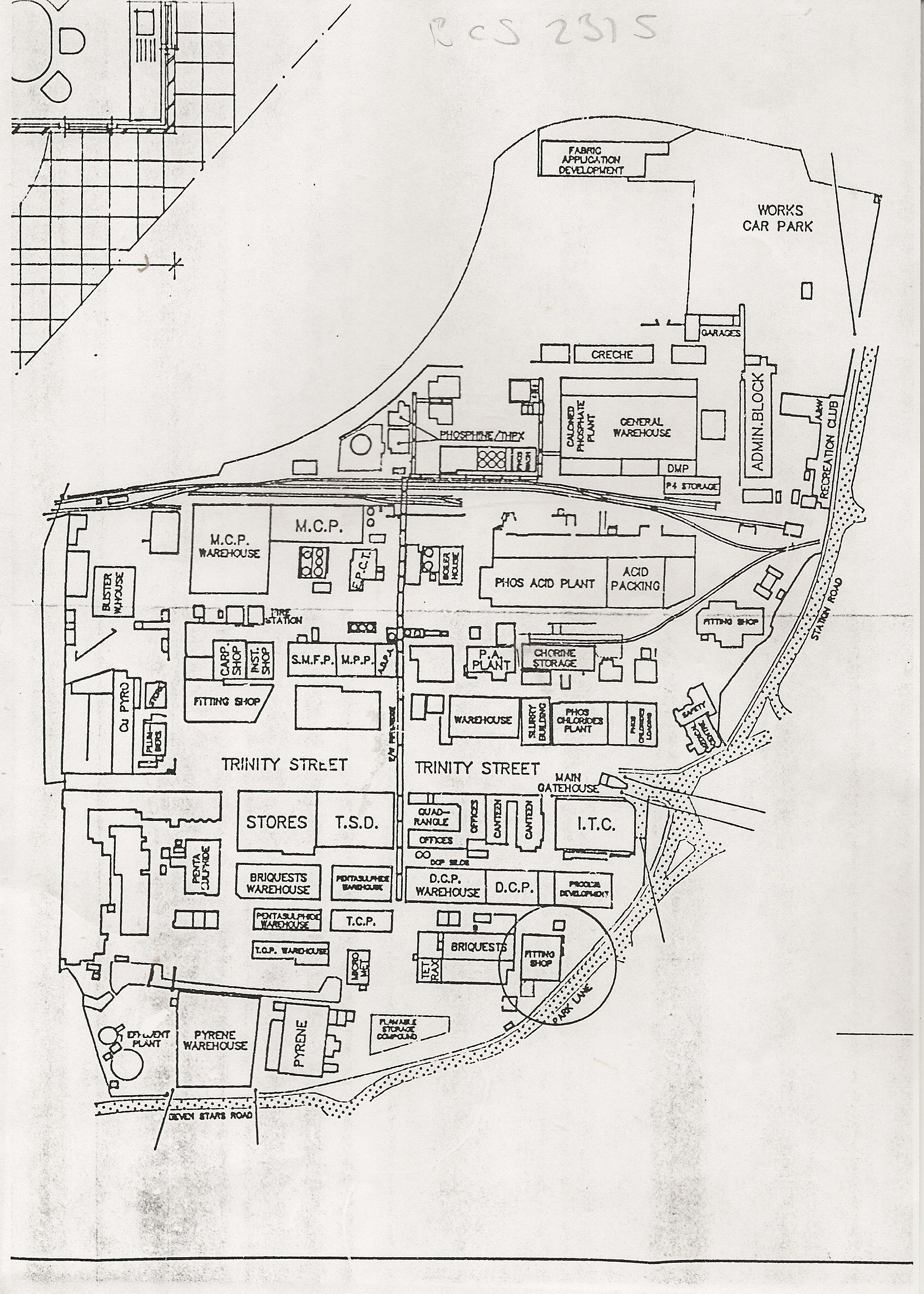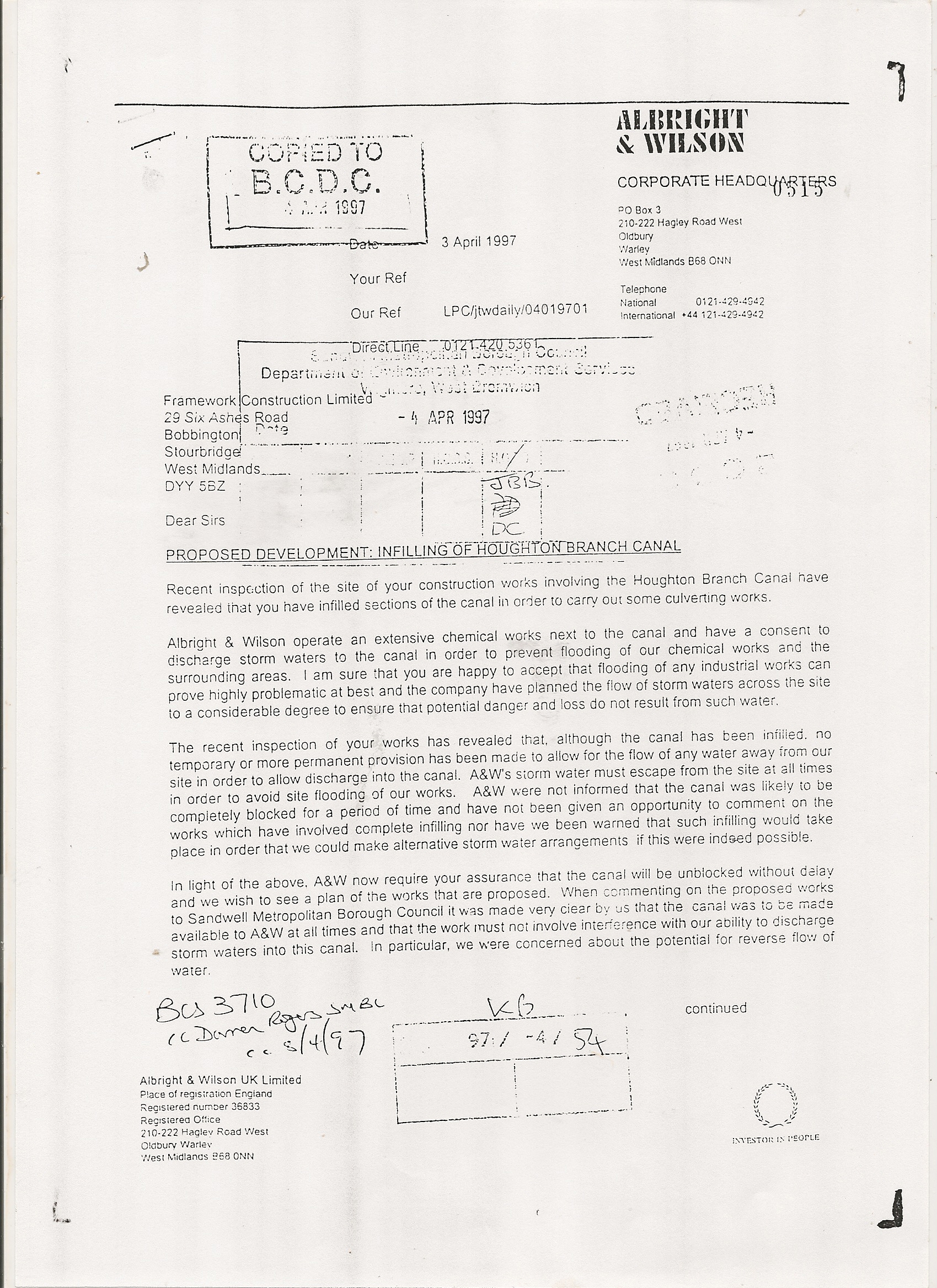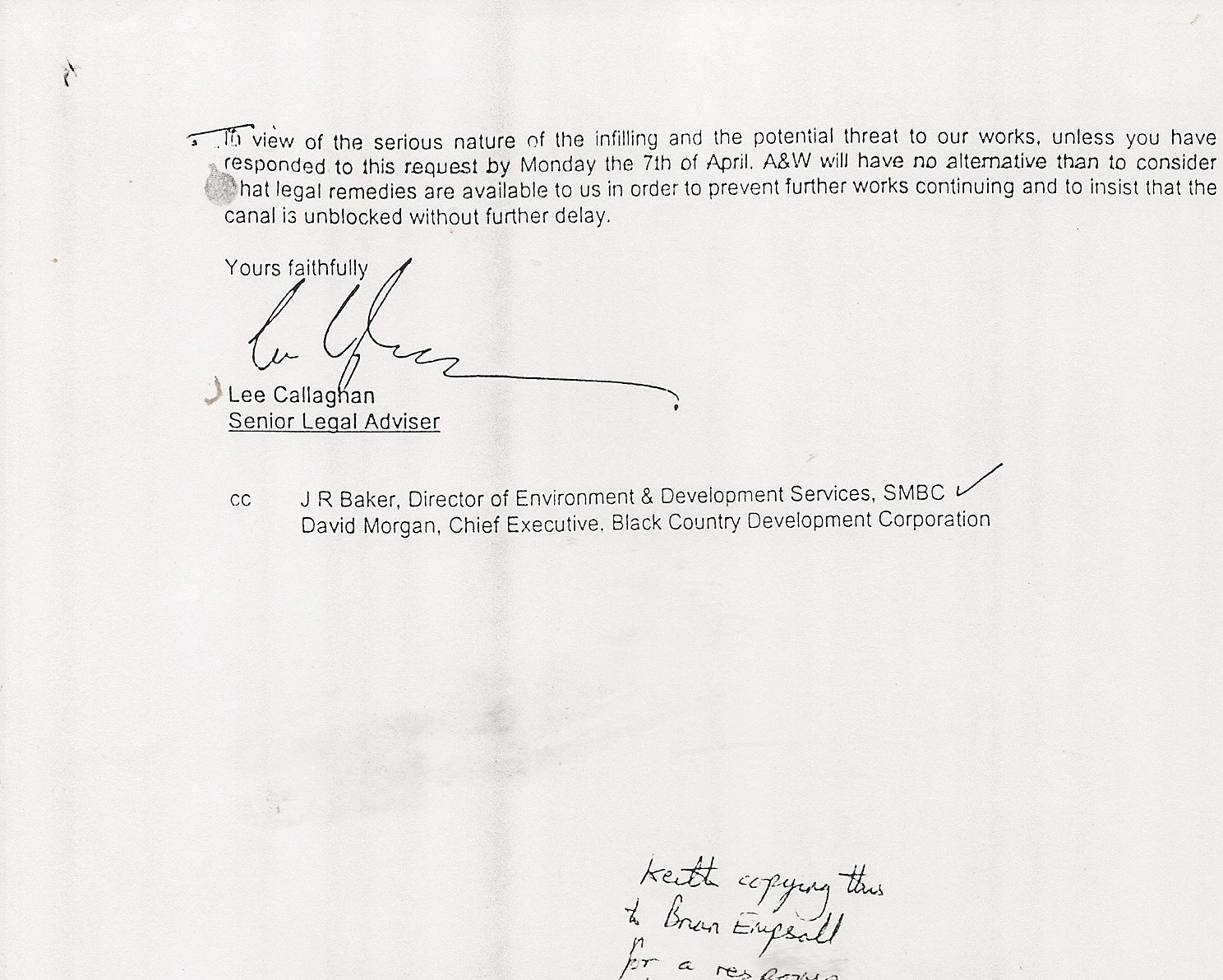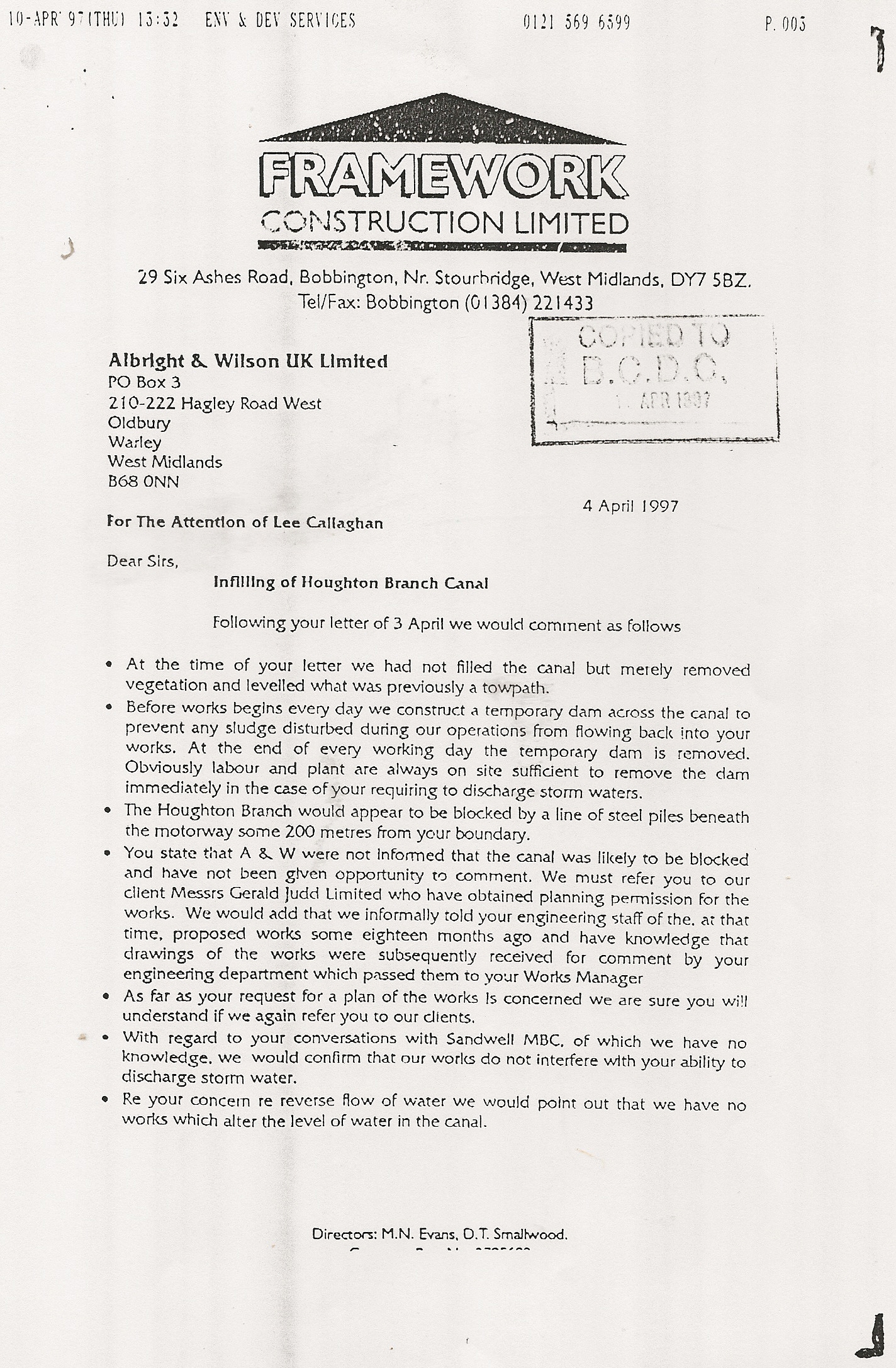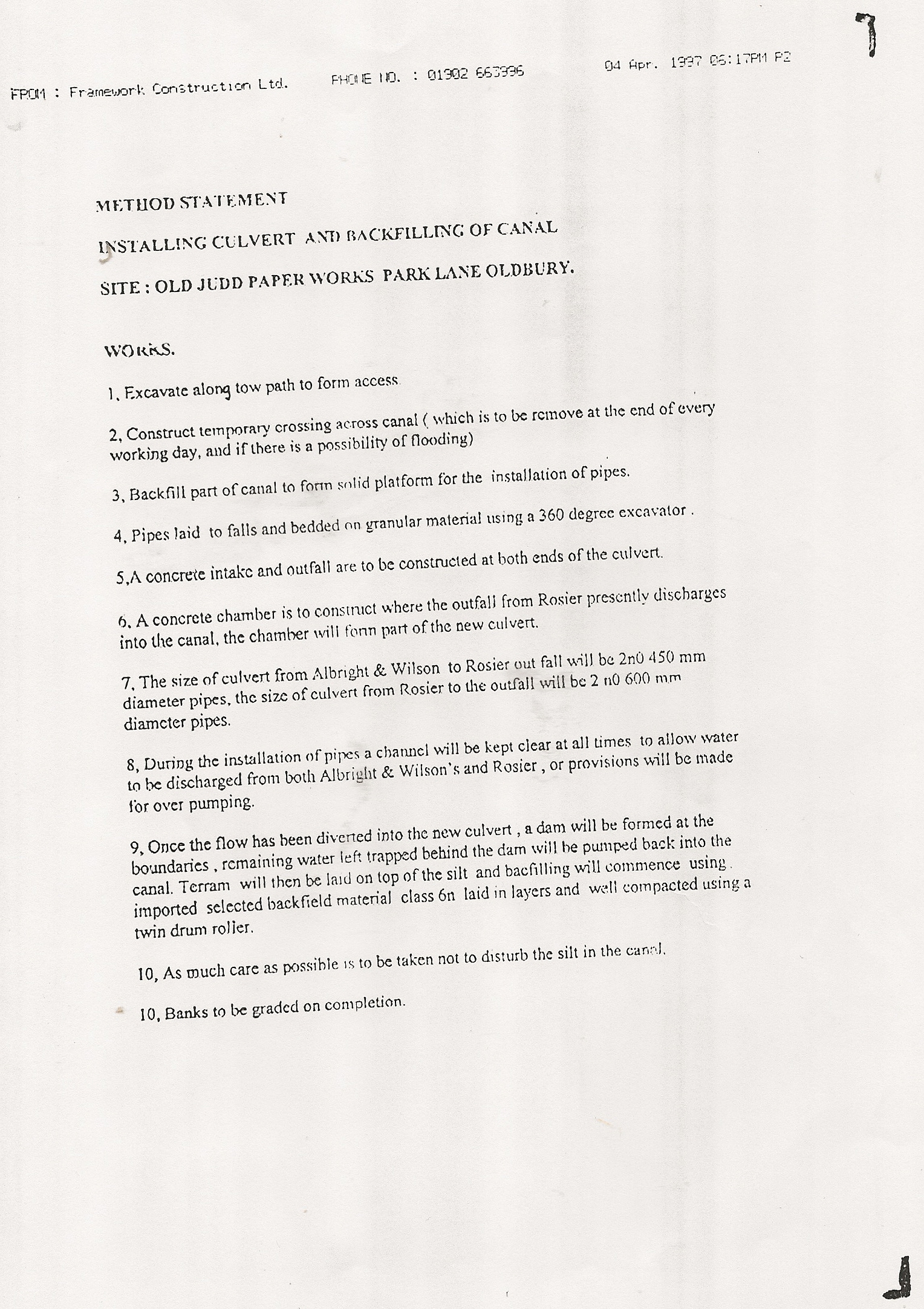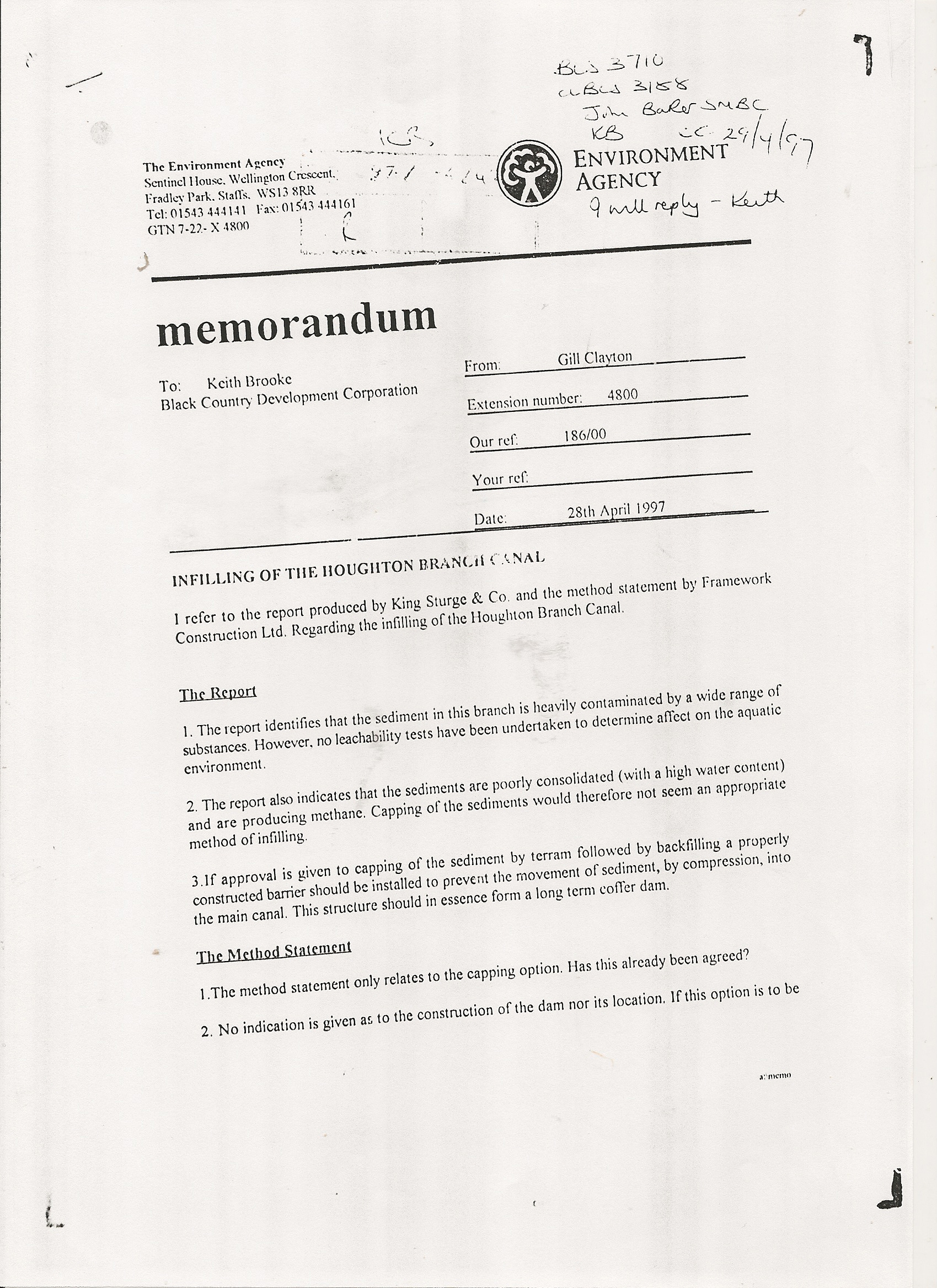Waste from the Houghton “chemical arm” was historically deposited into Rattlechain lagoon upto 1974, including waste from ICI operations connected by the same arm as well as Albright and Wilson discharges. It has also been confirmed as we have revealed, that British Waterways also dredged canal sediments in local areas of the BCN network.
In 1997 the EA conducted an audit of the Albright and Wilson site as it then stood.
“..at times of heavy rainfall storm water can overflow to controlled waters, namely the Chemical Arm Canal (an offshoot of the Birmingham Canal, Wolverhampton Level). This discharge is permitted and is controlled by the Agency under a separate discharge consent.”
In that same year a section of this canal was infilled, a study of sediment in this canal arm preceeding this authorised operation. BCS 3710 dealt with the “proposed infilling of the Houghton Branch canal, Park Lane, Oldbury.”
The following refers to a report carried out for Gerald Judd Ltd by Environmental Assessment Group (EAG) May 1996. “Sediment contamination Survey at Park Lane/Trinity Street, Oldbury.”
The report offered
- a quantitive risk assessment of the contamination of sediments in the part of the canal in the ownership of Gerald Judd Ltd (not owned by Rhodia)
- an assessment of the physical characteristics and estimated volumes of material
- dredging and disposal options
- an assessment of the quantity of material to be handled and associated costs.
The 25 page report was backed with several annexes of analytical reports related to sediment testing- the main point of note that no analysis was carried out for elemental/ white phosphorus which is rather surprising given the known use of the arm.
It noted “The canal supports extensive growth of aquatic vegetation… (and) there is substantial alga growth on the sediment surface, and the sediments have high organic contents.”
An outfall was noted on the Eastern bank of the canal operated by Rosier Services (formerly the ICI site). “The effluent drain crosses the site, and was constructed in 1969/70, close to a former drain. The outfall works include a three chamber silt pit.”
Although the discharge was consented by the EA
“only a limited list of determinands is monitored. At the time of sampling, the rate of discharge was substantial. The chemical arm also receives surface drainage from the Albright and Wilson facility. The discharge was consented by British Waterways Board, but should also (be) covered by the integrated Pollution control (IPC) Authorisation, issued by the EA (formerly HMIP) for
the chemical works.”
Testing of sediments were taken at 7 spaced out points and problems occured “it was found in the field that the methane generating potential of the sediments was substantial.”
A key to these approximate testing points is shown in the map below. The problems with “analysis” of such substances always tends to be devalued by environmental consultants with the view that levels of subtances can be “acceptable” if they are below a certain level. The problem arises over time when these set levels go down when it is resolved that levels that were thought to be “safe” are not as “safe” as they were first thought. It is in the interest of the environmental consultant (like a lawyer) trying to pull the wool over people’s eyes for their client to realise development potential. However that said this study was more realistic about the substances found. We have created links summarising some of the properties of the chemicals found in the sediment- which remember would have been dredged by Alfred Matty et al for transport to tip at rattlechain lagoon.
This study found with respect to trace metals “all the samples collected from the canal exceed both the Dutch “target” values and worldwide background levels by substantial margins”
Furthermore it noted
“Hexachlorobenzene in samples 1,3 and 11 were (1.30-5.1 mg/kg)
4-chloroaniline in sample 3 (700ug/kg) and Hexachlorobutadiene in samples 3 and 11 (390-710 ug/kg)
The concentration of hexachlorobenzene exceeds the dutch “limited” value for sediments of 4ug/kg by about 1 thousand fold.”
Concentrations of volatile organics found significant levels of
Of acetone near to the outfall the study noted that it “is strongly indicative of a constant industrial source.”
Semi-volatile organics also yielded significant concentrations at all sampling points in the sediment of amongst other subtances-
- Acenaphthylene,
- Dibenzofuran,
- Fluorene,
- Phenanthrene,
- Fluoranthene,
- Pyrene
- Chrysene,
- and bis-(2-Ethylhexyl)phthalate.
Analysis of Volatile organics in the sediments and semi-volatile organics in the sediments are also given in the following tables.
Conclusions made concerning the origins of the detected substances are rather poor to say the least. “A proportion of the metals, particularly lead could have been derived from atmospheric emissions and run-off from the M5.”
THIS IGNORES ANY FOCUS ON THE CHEMICAL FACTORIES DIRECTLY DISCHARGING INTO THE CANAL- ALBRIGHT AND WILSON HAD SPECIALIST LEAD BURNING CARRIED OUT ON SITE.
NOTE THE LOCATION OF THE FORMER PYRENE WAREHOUSE AT THE SITE- IT DOESN’T TAKE A GENIUS TO FIGURE OUT WHERE THIS CHEMICAL CONTAMINATION IN THE SEDIMENT ARISED FROM!
Importantly noted was “oxidation of the samples, due to dredging and exposure to atmospheric oxygen, would be likely to generate sulphuric acid. This can cause release of trace metals from the dredged sediments. The concentrations of trace metals released could be substantial.”
In characterising the significance of contamination it reported “to summarise; the sediments are highly contaminated by trace metals, oil, some industrial solvents, hexachlorobenzene and PAH.” (polycyclic aromatic hydrocarbons)
These problems associated with the contamination of the sediments in the chemical arm gave some conclusions towards dredging and disposal options on page 19 of the report. “The option of capping the sediments could be considered . However, the methane gas generation rates and need to consolidate the sediments compromise the feasibility of this option.” It also considered canal dewatering and “dry dredging”- which would have been interesting given their lack of testing for P4!
This was the option recommended by the consultant.
Planning application BCS 3170 generated some interesting correspondence between Sandwell council, the applicants, Albright and Wilson and The Environment Agency. Below are some of these letters and comment sheets which tell the story.
Council statements.
ALBRIGHT AND WILSON CONCERNED ABOUT “ENVIRONMENTAL POLLUTION” IS LIKE THE POT CALLING THE KETTLE BLACK!
Legal arguments.
Environment Agency comment 1
Proposed method statement.
Environment Agency comments.
With this information in mind, we asked a Freedom of Information request to The Environment Agency concerning the direct links between The Houghton chemical arm and the extent of its proven contamination and Rattlechain lagoon.
WE BELIEVE THAT THE CONTENTS OF THE SEDIMENT FOUND IN THE CHEMICAL ARM FROM THIS STUDY ARE MORE REFLECTIVE OF WHAT LIES BENEATH RATTLECHAIN LAGOON. WE BELIEVE THIS BECAUSE THE EAG STUDY WAS NOT BOUGHT BY, INFLUENCED IN ANY WAY BY OR ALTERED BY THE MANAGEMENT OR DIRECTORS OF ALBRIGHT AND WILSON OR RHODIA UK LTD.





